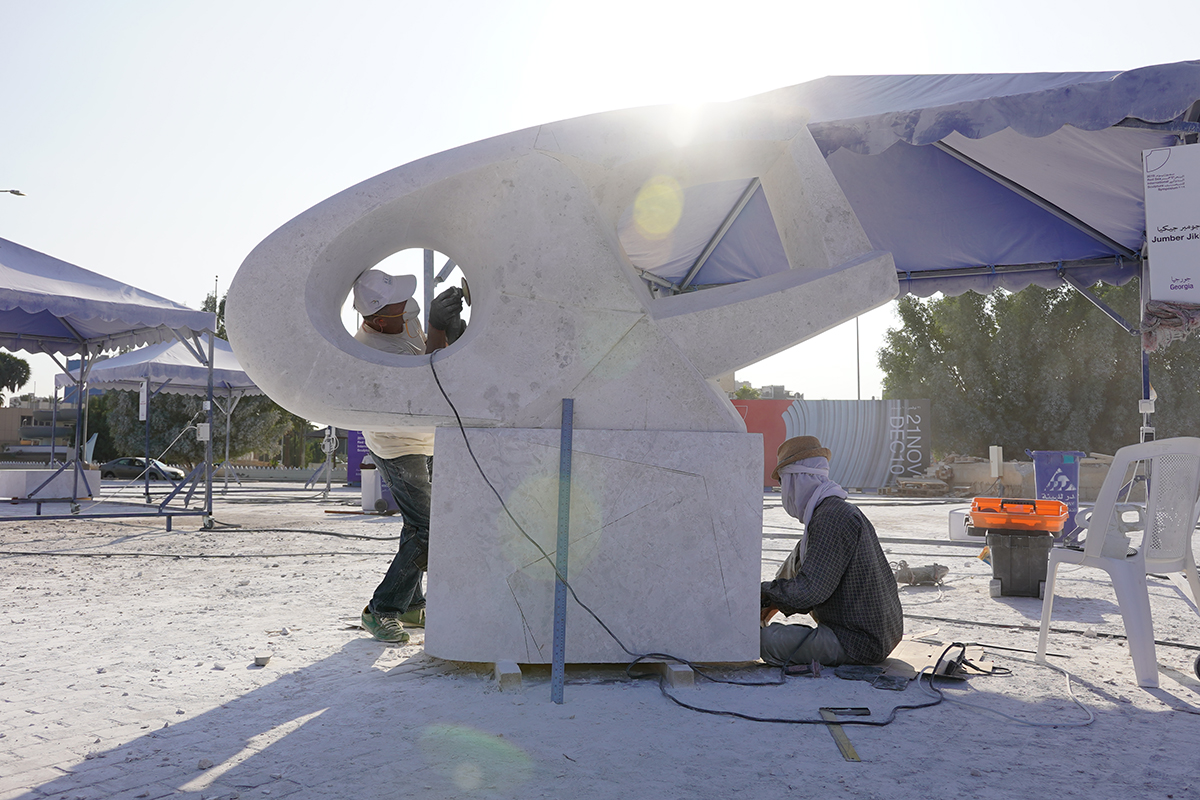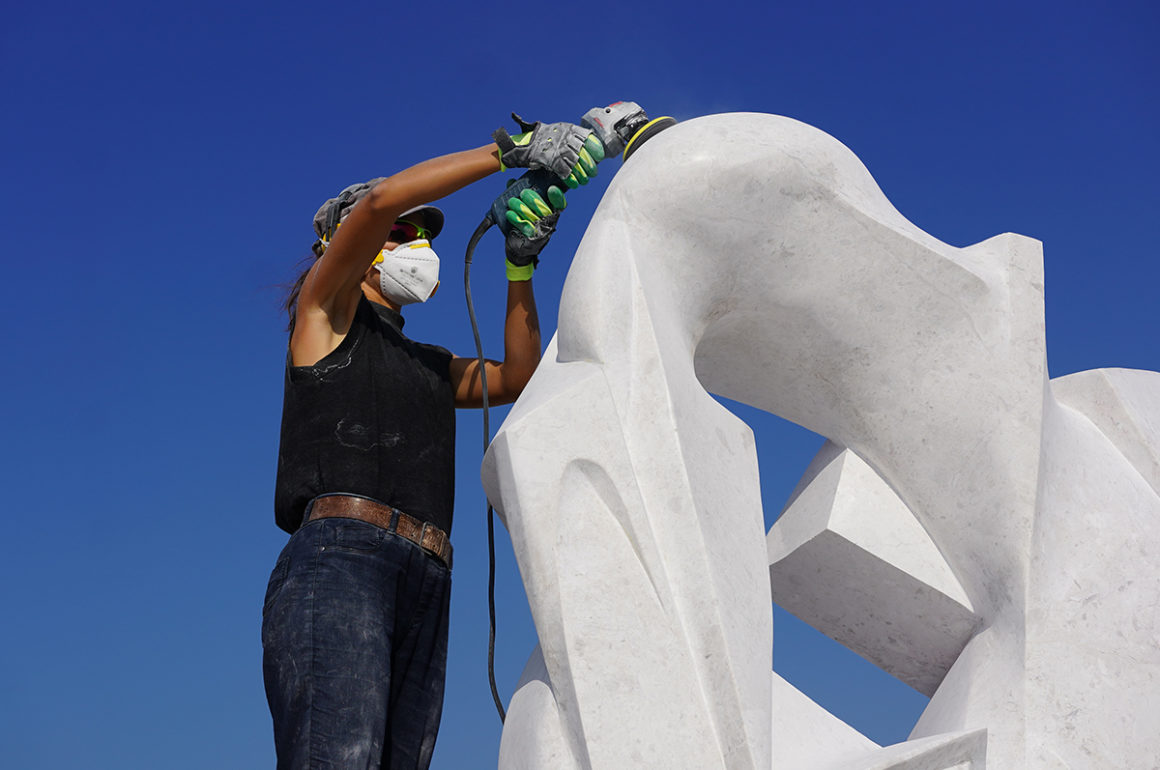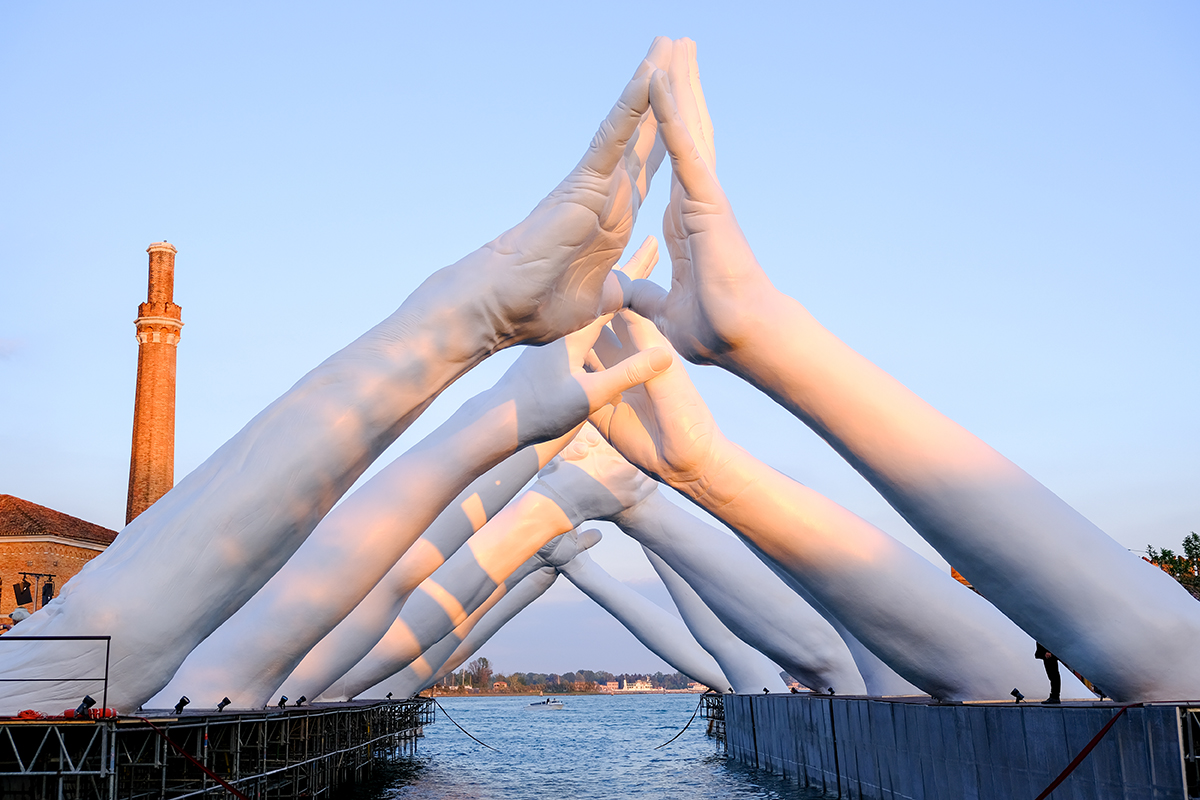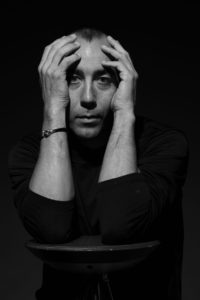
One of the participating artist’s in the process of sculpting marble at the inaugural edition of Jeddah’s Red Sea Sculpture Symposium
Saudi Arabia is working hard to rediscover its cultural roots, promote contemporary art and establish itself as a cultural destination, with a series of new art events and residencies. Following on from the inaugural edition of Jeddah’s Red Sea Sculpture Symposium, Art & Digital Editor Millie Walton investigates the rise of the coastal city as a new cultural hub
In recent years, Saudi Arabia has been creating for itself a cultural renaissance, catalysed by the reforms of Crown Prince Mohammed Bin Salman, the country’s 32-year-old de facto leader. In 2018, the Kingdom opened the doors to cinemas after a forty-year hiatus, announcing the start of a new vision for the country’s ongoing cultural development, with an aim to support local craft as well as attract international creatives. Led by the Ministry of Culture, the vision seeks to reposition the country it as a dynamic place for business and leisure, responding to the demands of a new, youthful generation who are tech-savvy and plugged into the pulse of global culture.
Follow LUX on Instagram: luxthemagazine
Jeddah is one of the main hubs in this strategy. Once seen as culturally conservative, the city is now home to hip contemporary art galleries, graffiti murals and public art installations. Later this year, Art Jameel, a nonprofit organisation set up by the wealthy car-dealing family of the same name, is due to open Hayy (derived from the Arabic word from neighbourhood), an ambitious creative complex with studios and exhibition spaces, whilst the Ministry of Culture launched its first arts initiative in the city last year in the form of a cross-cultural live-sculpting event.


The artists could be watched live sculpting at a location in Jeddah’s historic district of Albalad
The inaugural Red Sea International Sculpture Symposium invited twenty international and local artists to hand sculpt free-standing monoliths over a three week period (21 November – 10 December 2019), using blocks of white marble imported from the Sultanate of Oman. Participants were asked to create artworks in response to the city’s geographical location and historical heritage as a trading hub, whilst also drawing on the diversity of its contemporary society.

Agnessa Petrova, 2019

Takeshi Kubo, 2019
The sculpting itself took place between 8am and 6pm at a location in Jeddah’s historic district and UNESCO heritage site Albalad, purposefully distanced from the city’s main cultural attractions and tourist hotspots so as to welcome new art audiences whilst also providing artists the opportunity to interact with local residents throughout the day.

‘This global interaction reflected Arab and international cultural experiences on the artistic and cultural scene in historical Jeddah. This enriches the local scene because it shows positive results and contributes to the recipient’s diverse visual nutrition,’ commented Issam Jamil, one of three participating Saudi sculptors along with Rida Alalawi and Kamal Almualem. European artists included Michael Levchenko (Ukraine), Kamen Tanaev (Bulgaria), Jose Carlos Cabello Millan (Spain), Mario Lopes (Portugal), Jo Klay (Germany), Sylvain Patte (Belgium), Butrint Morina (Kosovo), Aggnessa Petrove (Bulgaria), Anna Maria Negara (Romania) and Anna Rasinska (Poland) with Asian artists Takeshita Kubo, Fan Chilung-Lien and Lin Li Jen, and Arab artists Ali Jabbar (Iraq), Hisham Abdulmuty (Egypt) and Hany Fisal (Egypt).
Read more: Why we love Hublot’s limited edition spring timepieces
Whilst all of the selected artists’ practices incorporated stonework, each participant specialised in different materials and techniques, and for some, it was their first time carving marble, a material chosen for its aesthetic appeal, durability and historic significance.

Ali Jabbar, 2019
The finished pieces varied in both scale and style with some reflecting the city’s architectural magnificence and the natural environment of the Red Sea, whilst others evoked modern and abstract minimalist forms.
Still standing in the location in which they were originally sculpted (with plans to relocate around the city in the near future), the works appear haunting and luminous against the vibrant colours and textures of Albalad, providing a striking symbol of the city’s new-found creative energy.

Anna Rasinska, 2019
An introduction to Jeddah’s wider cultural scene
Jeddah’s Art Residency Initiative
This year, the creative momentum is set to continue with Jeddah’s newly launched Art Residency Initiative, which invites artists to attend six-week residency programmes at various points across the year. Alongside the residencies, the city will also feature events, showcasing the Ministry of Culture’s annual theme: the ancient artistic practice of Arabic calligraphy.
21,39 Jeddah Arts
Organised by the Saudi Arts Council, 21,39 Jeddah Arts is a contemporary art festival featuring gallery exhibitions, workshops, and panel discussions with many of the region’s leading creatives. This year’s edition (open until April 19) is entitled I Love You, Urgently and focuses on the global climate emergency with artists presenting a diverse collection of work including everything from Islamic painting techniques and calligraphy installations to ethically-made clothing and digital print collages.
Red Sea Film Festival
Whilst the launch might have been postponed, the inaugural Red Sea Film Festival promises a diverse 10-day program of screenings and talks, supporting emerging and established talent from Arabic and International cinema.
Hayy: Creative Hub
Set to open in the winter of 2020-21, Haay: Creative Hub is a 17,000-square-metre arts complex developed by non-profit organisation Art Jameel. Designed by UAE design studio waiwai, the space will include art and design galleries, performance and comedy clubs, cafes, artist studios and a theatre as well as an independent film cinema designed by Jeddah-based practice Bricklab.
To learn more about the Ministry of Culture’s forthcoming initiatives, visit: moc.gov.sa/en












Recent Comments